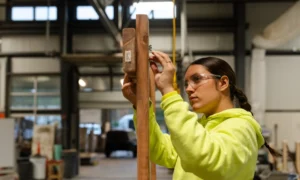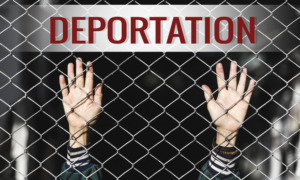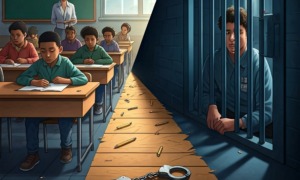Cheltenham, Md.—It’s a hot summer Friday afternoon at Maryland’s aging Cheltenham Youth Facility – one of an increasing number of juvenile corrections facilities facing federal civil rights investigations.
Cheltenham’s four cottages are temporarily vacant as the 65 teenage boys assigned here attend classes on campus. In one room, some youths watch an inspirational video about boxer Ruben “Hurricane” Carter; a few of them are dozing.
A few years ago, Cheltenham bulged with more than 300 kids, far over its official capacity of 110. Last year, with the inmate population over 200, police were called in to quell a riot that sent two youths to a hospital. This year, assault charges were filed against four staff members. The state brought back a former supervisor to run the place, and farmed out kids to other locations around the state.
By then, the U.S. Department of Justice (DOJ) had sent investigators to see how Maryland treated its youths in custody – just as the department has done in dozens of jurisdictions over the past decade.
In April, a scathing DOJ report on Cheltenham and a juvenile facility in Baltimore documented abuse of residents by staff and other youth, inadequate medical and mental health care, and “insufficient assessment of suicidal youth.” The DOJ laid out a 27-point plan of minimum “remedial measures,” including better inmate classification and improved staff training. The department is negotiating a plan of correction with the state.
What’s happening in Maryland typifies cases that DOJ civil rights attorneys have brought from coast to coast over the past decade – efforts that have shined public attention on the many shortcomings of juvenile justice facilities. Yet some youth advocates question whether these efforts produce results.
“The Justice Department has brought to light a history of neglect and inattention,” says Kenneth Montague, a former Democratic state delegate chosen by Gov. Robert Ehrlich (R) to head Maryland’s renamed Department of Juvenile Services. (The word “Justice” was dropped.) Montague says he already has presided over “a lot of changes for the better,” but he is disappointed at the “slowness with which government moves.”
Juvenile institutions stand out as exceptional targets for a Justice Department civil rights enforcement unit that has not been particularly prominent during the Bush administration. Since early 2001, settlements have been reached with four states – most recently Arizona, in mid-September – while investigative findings have been filed in eight states, and investigations have been launched in four more.
Public and private facilities held 102,388 offenders in 2002, says the National Center for Juvenile Justice.
To hear the Justice Department tell it, the flurry of cases does not indicate a national scandal involving poor conditions for incarcerated kids. Assistant Attorney General Alexander Acosta, the department’s civil rights chief since August 2003, says he is merely enforcing the 1980 Civil Rights of Institutionalized Persons Act (CRIPA), which also covers adult prisons, mental health facilities and nursing homes.
Juvenile justice advocates welcome the Justice Department’s interest, although some question how serious the Bush administration is about pressuring for reform. Critics suspect that the White House sees juvenile investigations as a “safe” subject – protecting children – that carries little potential of offending anyone important, as might a civil rights crusade against big business or powerful government agencies.
David Utter, director of the Juvenile Justice Project of Louisiana, points to a case in his state, in which the DOJ complained about poor conditions at a facility in Tallulah, but refused to seek a court-ordered closure. Utter sees that as evidence that under U.S. Attorney General John Ashcroft, the DOJ “is less concerned about health and safety” of juveniles than it was under previous administrations.
In a somewhat odd turn, state officials by and large do not object toWashington’s intervention. States concede that most of the DOJ charges are well documented. The larger question is how hard they should be pushed to repair buildings and to hire and train more qualified staff – all of which cost money that is in
short supply.
Feds Get Aggressive
Juvenile corrections experts say it should be no surprise that federal investigators are finding poor conditions in many facilities. The “Conditions of Confinement” study of the nation’s juvenile detention and corrections centers, conducted by Abt Associates for the federal government in the early 1990s, found “serious and widespread problems” in overcrowding, health care, security and suicide prevention. (The number of public facilities had increased from the 984 surveyed by Abt to 1,182 by 2002.)
A typical cycle in the evolution of a juvenile detention or treatment facility is described by Ned Loughran, executive director of the Council of Juvenile Correctional Administrators: Staff and youth generally get along when the facility is opened. Then “benign or not so benign neglect sets in quickly. Something triggers events, such as budget cuts or the physical plant getting old, and things begin to deteriorate – kids assaulting other kids, predatory staff, suicide.”
After the Conditions survey was issued in 1993, it was just a matter of time before federal authorities moved in, prompted by complaints from advocacy groups, families of incarcerated kids, state legislators and news media accounts.
The first in the recent series of cases was filed by the Clinton administration against Puerto Rico in 1994. That was followed by “findings letters” or lawsuits in Kentucky, Louisiana, Georgia, Arkansas, Nevada, South Dakota, California, Mississippi, Arizona, Maryland and Michigan. Investigations are under way in California, Indiana, Hawaii and Oklahoma.
Some juvenile justice observers attribute the surge of cases largely to a corps of career attorneys in the civil rights division’s special litigation section who came on board in the latter days of the Clinton administration. Between 20 and 30 lawyers are assigned to juvenile justice cases at any one time.
Justice Department involvement can be an important catalyst for reform. In its most extreme form, a federal investigation can lead to a consent decree that requires states to make improvements and is enforced by a federal judge. More common are agreements in which states pledge to DOJ to make improvements.
That’s where much of the dispute lies over the effectiveness of the federal probes.
Tough Enough?
Civil-rights chief Acosta, a labor lawyer and former member of the National Labor Relations Board, believes more will be gained in the long run if state officials play a strong role in designing changes, rather than having changes dictated from Washington. Noting that consent decrees typically are in force for only five years, Acosta says “it is much better if state officials devise solutions themselves. They will have ownership over them, and [the solutions] will be in place long after we’ve left.”
His philosophy is that the Civil Rights Division should deal with states “as full partners. Our job is to fix the problem, not fix the blame.”
Acosta believes he can make significant accomplishments by talking directly with governors about prospective cases. “Senior state officials have been very responsive in getting ahead of the problem and cooperating with the resolution,” he says. He declines to identify governors with whom he has negotiated.
One place where a voluntary agreement doesn’t seem likely is Mississippi – a case that illustrates how aggressive the DOJ is willing to be, for better or worse.
An investigation by the Civil Rights Division, prompted largely by a complaint from U.S. Rep. Bennie Thompson (D-Miss.), led to a federal “findings letter” to Gov. Ronnie Musgrove in June 2003. The letter laid out a long series of charges involving the Oakley Training School in Raymond and the Columbia Training School in Columbia. Justice cited such practices as hog-tying (shackling inmates’ feet together and wrapping chains around the restraints) and pole-shackling (shackling youths to poles in public places).
Thompson, who says “hellholes like Columbia and Oakley should not exist,” held a town meeting in June in which Civil Rights Division attorney Brad Schlozman called conditions at the schools the worst DOJ had encountered in more than two decades of experience under CRIPA.
Justice viewed the situation as so serious that it insisted on a consent decree and sued the state. State Attorney General Michael Moore complained after the case was filed last December that, “unfortunately, instead of spending hundreds of thousands of dollars improving the lives of their children, Mississippi and the federal government will be spending hundreds of thousands of dollars paying lawyers, which is ridiculous.” The case seems nowhere near resolution; the trial is scheduled for December 2005.
Even though the DOJ took Mississippi to court, some advocates give the department only fair marks for its level of aggressiveness. Danielle Lipow of the Southern Poverty Law Center in Montgomery, Ala., which represents parents of children abused in Mississippi facilities, complains that federal law does not allow the Justice Department “to go beyond the bare minimum” of pressing for fixing poor conditions by taking a stand against “unnecessary
institutionalization.”
Giving States Leeway
Neighboring Louisiana offers another good illustration of the debate.
Advocacy groups and federal investigators have cited a long series of abuses at the now-closed juvenile institution at Tallulah, where a judge said in 2002 that he had “grave concerns for the physical and mental health” of youths. Guards at Talullah typically would “throw kids into isolation” for days at the slightest provocation, says Utter of the Juvenile Justice Project of Louisiana.
Federal and state officials reached a tentative agreement in 1999 that resulted in Louisiana spending tens of millions of dollars to improve education and medical care at Tallulah and other facilities. The state slashed its incarcerated juvenile population from more than 2,000 to 600, putting more teens in community programs.
Negotiations on details extended into the Bush administration – under which, Utter says, federal attorneys began deferring to state officials’ promises that they would make necessary changes, rather than seeking court-ordered changes. “That’s a pretty weak agreement for a state that has proved not to care about these kids,” he says.
But even though the DOJ did not demand the closure of Tallulah, the state closed it last June, transferring its residents to other facilities. Gov. Kathleen Blanco (D) called the shutdown “a philosophical shift in the way we deal with troubled youth.”
Lipow, of the Southern Poverty Law Center, advocates reforms like the widely praised overhaul in Missouri that has resulted in the closure of large state training schools in favor of smaller, community-based programs for delinquents. The DOJ’s Acosta says his legal mandate under CRIPA doesn’t go that far. He says the department can seek institutional fixes but not demand shutting down training schools.
The Louisiana case – as well as one in Georgia, where Justice filed a “findings letter” in 1998 – shows how cases can go on for years in a back-and-forth exchange between Washington and state officials. After a settlement is reached, both sides agree on expert monitors who check on conditions periodically, while policy-makers decide on what institutions can do to make permanent improvements to satisfy requirements sought by federal attorneys.
Orlando Martinez, who ran Georgia’s juvenile corrections system from 1999 until last year, is among those officials who believe a long-running DOJ case can keep pressure on legislators to deal with problems. Martinez says federal charges about failures in Georgia’s education and mental health services for incarcerated kids, among other issues, were “absolutely justified.” While the case has been pending, state appropriations for the juvenile justice system have quadrupled.
Nevertheless, the state has yet to fulfill its requirements. A recent report from criminologist James Austin, who is monitoring progress, declared that Georgia “has not developed a specific policy regarding provision of adequate mental health care.”
As with Louisiana, critics say the DOJ fell short in Georgia by not demanding a court-ordered consent decree to guarantee reforms. In Georgia, it was the DOJ under President Clinton and Attorney General Janet Reno that “gave away the store” in a 1998 settlement, charges Mark Soler, president of the Washington-based Youth Law Center.
Cases to Watch
Several pending cases will tell the tale of the DOJ’s effectiveness under the Bush administration in getting states to reform their systems.
In Arizona, the department filed an extensive findings letter in January after three youths committed suicide at the Adobe Mountain School for boys in Phoenix between April 2002 and March 2003. Justice said that “even basic services, such as medical and mental health care, failed to satisfy constitutionally minimum standards.” The department also charged that conditions were poor at a school for girls in Phoenix and another for boys in Tucson. Gov. Janet Napolitano (D), a former U.S. attorney and state attorney general, was familiar with the facts and moved promptly to negotiate.
The new settlement, in which the state agreed to make improvements in staffing and in programs such as suicide prevention, was called “a step forward” by Beth Rosenberg, senior program associate at the state’s Children’s Action Alliance. Like other civil rights advocates, however, Rosenberg would prefer that large institutions that are “old, decrepit, and not safe for kids” be torn down – a step the DOJ won’t seek – rather than getting short-term repairs. Still, Rosenberg credits the department with bringing to light a large amount of “abuse and inadequate treatment and mistreatment.”
The Maryland story could have a similar ending. Critics have long called for closing the Cheltenham facility and a facility in the Baltimore area, called the Charles H. Hickey Jr. School. The latter was a troubled site under the 11-year management of the for-profit Correctional Services Corp./Youth Services International. Maryland took back control this year.
Youth advocates fear that the DOJ and Gov. Ehrlich will agree to limited changes, such as cleaning up buildings, that won’t fix underlying problems in services. “We do not believe that [Cheltenham and Hickey] can be fixed,” says Heather Ford of the Maryland Juvenile Justice Coalition. “They should be torn down.”
While advocates and government officials disagree on how hard the Justice Department should press for reform, civil rights chief Acosta and Loughran of the Council of Juvenile Correctional Administrators agree that federal investigations can focus public attention on the issue and spur legislators into action.
“The silver lining may be that it results in more resources” devoted to juvenile justice, Loughran says.
However the federal investigations end in Maryland and elsewhere, expect the DOJ to remain active investigating juvenile facilities. “There’s no question that reforms are occurring,” says Austin, the Georgia case monitor. “The only debate is whether they’re happening fast enough.”
Resources
Danielle Lipow, attorney
Southern Poverty Law Center
Montgomery, Ala.
(334) 956-8200, www.splcenter.org
Beth Rosenberg, senior program associate
Children’s Action Alliance
Phoenix, Ariz.
(602) 266-0707, www.azchildren.org
David Utter, director
Juvenile Justice Project of Louisiana
New Orleans, La.
(504) 522-5437, www.jjpl.org
U.S. Department of Justice
Civil Rights Division, Special Litigation Section
Washington, D.C.
www.usdoj.gov/crt/split
(202) 514-2008































